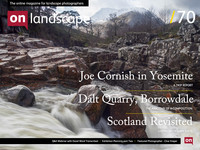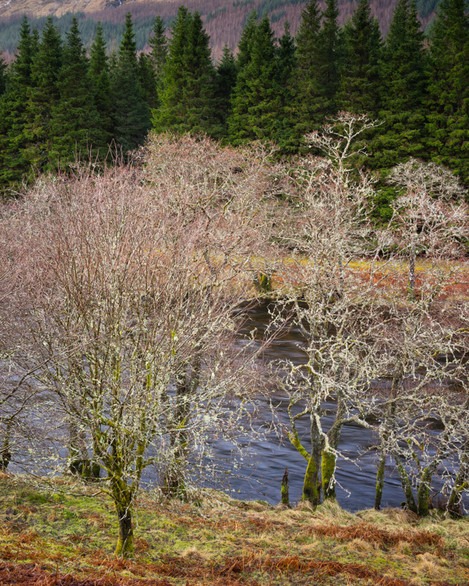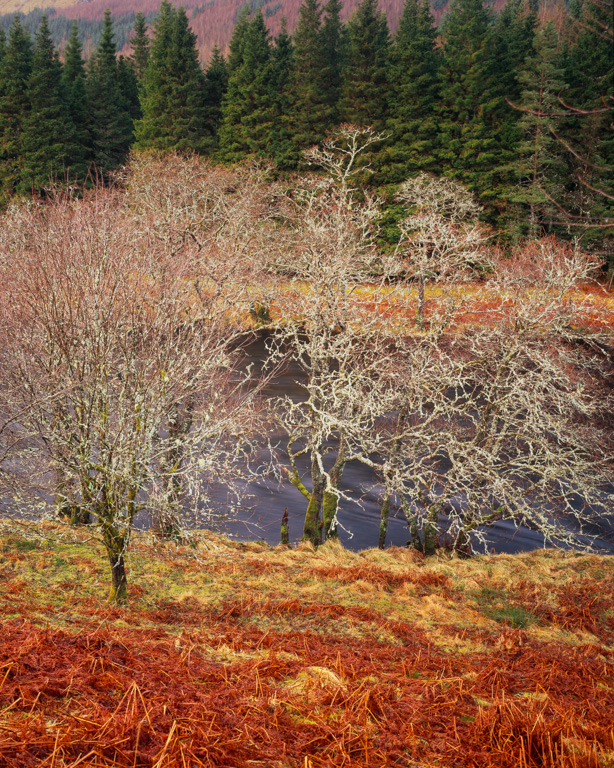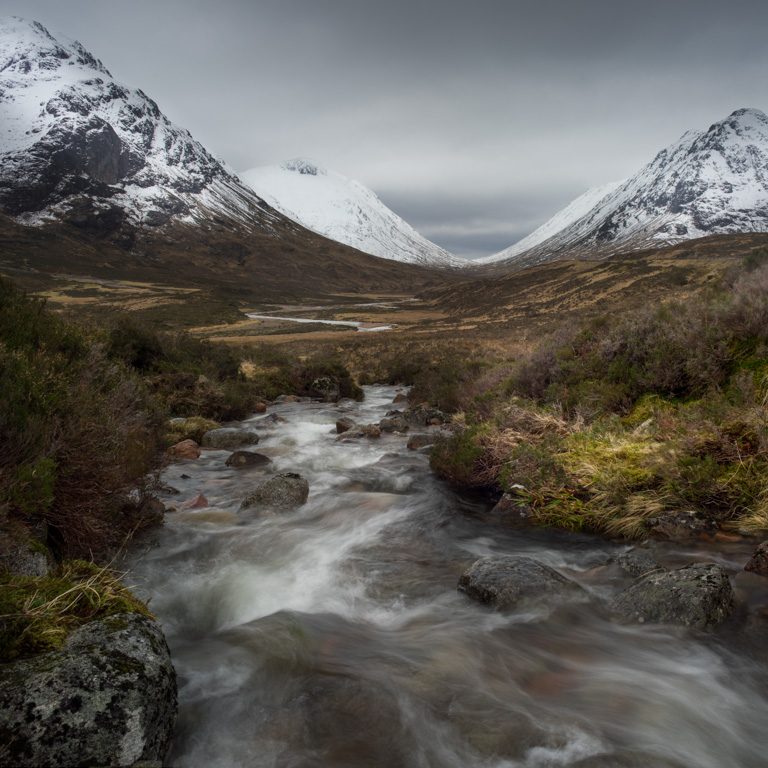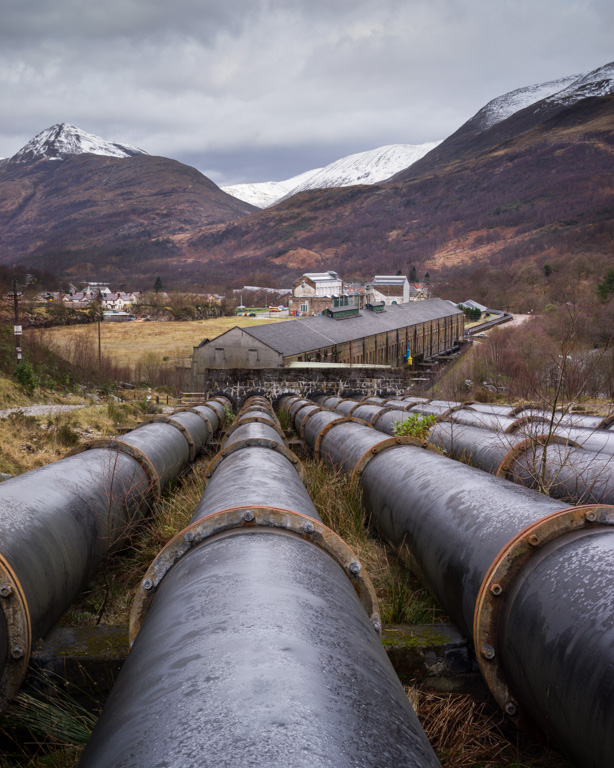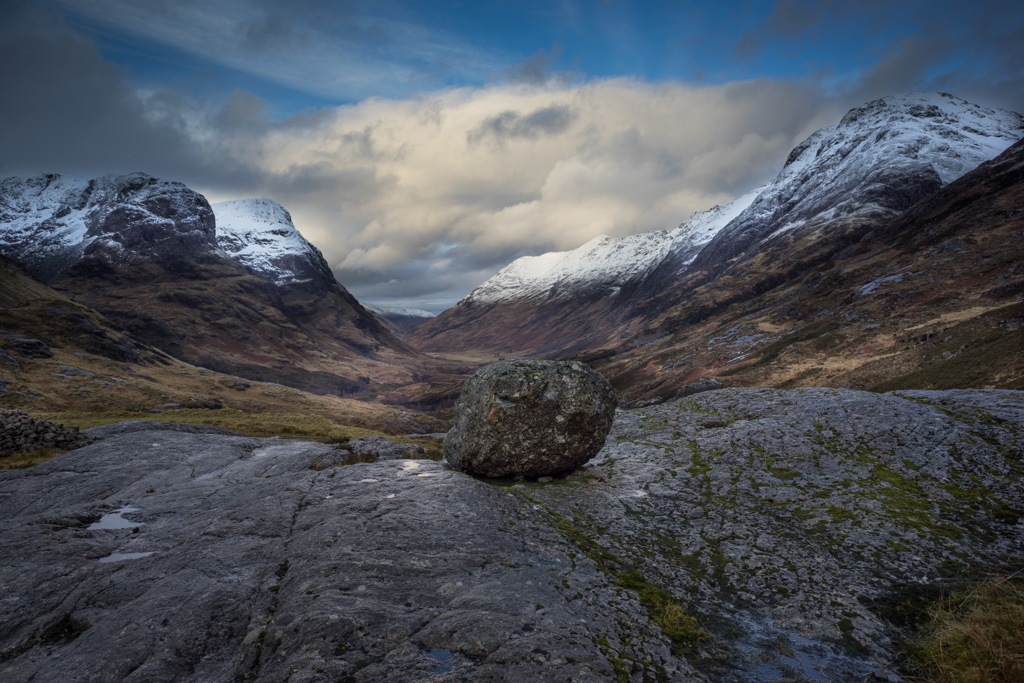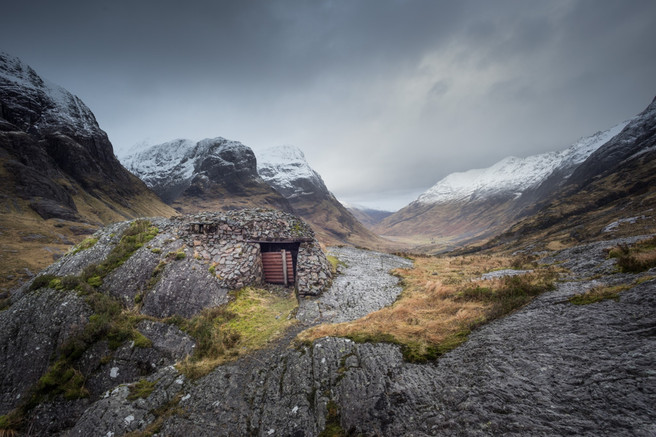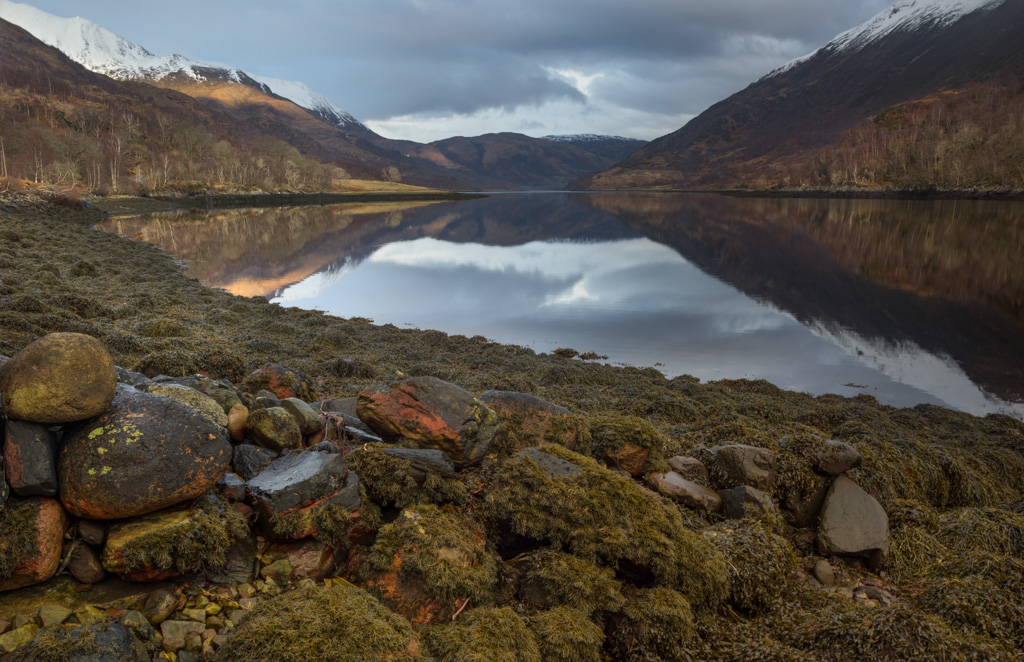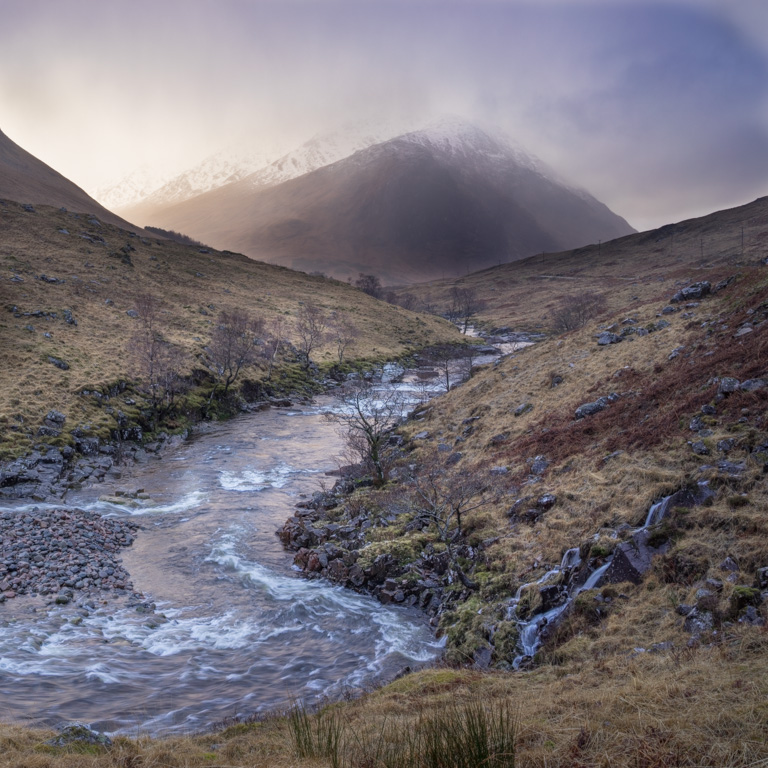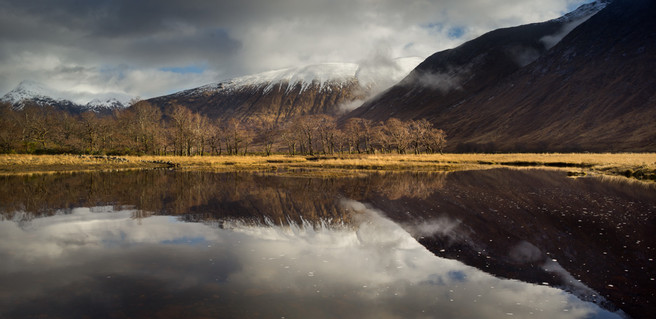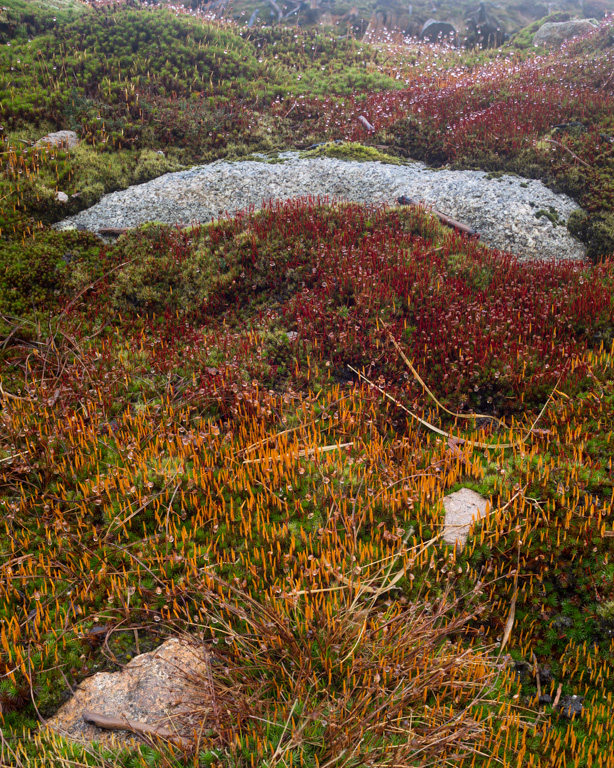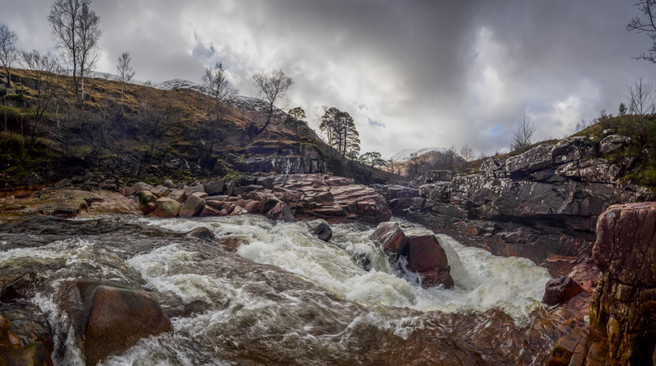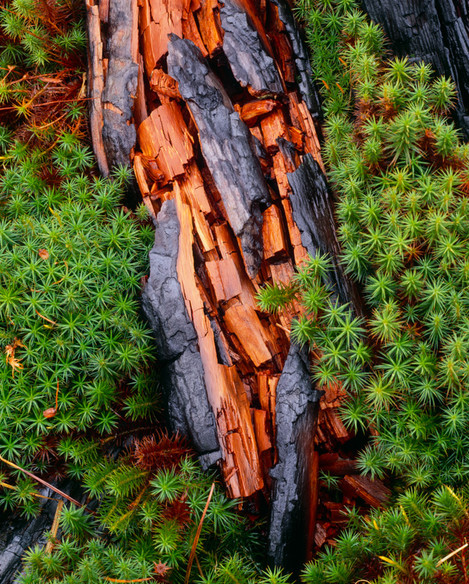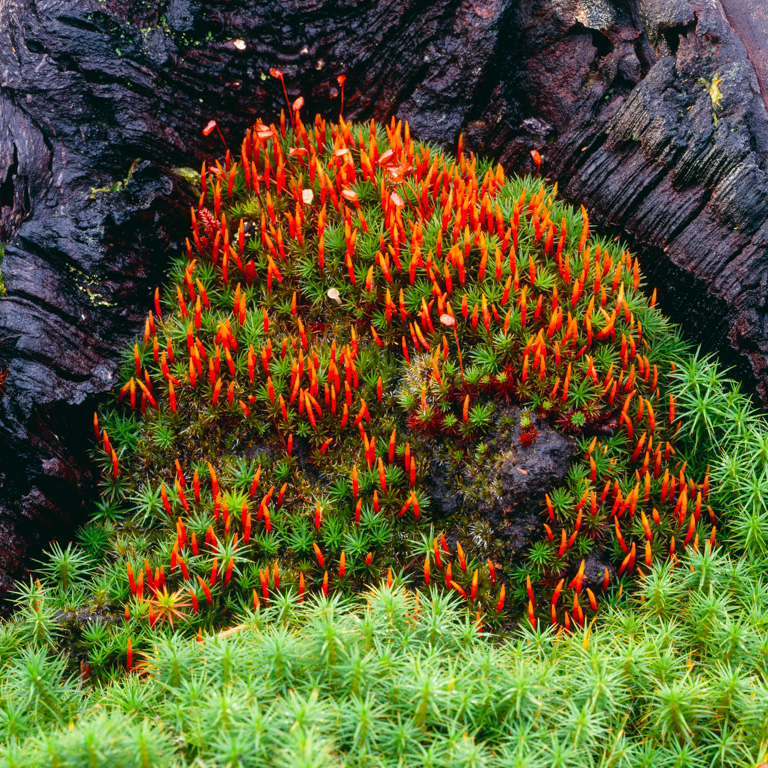In the third part of our look at the A7R we take it ‘on the road ‘ to Glencoe for a week of Winter photography’
The first two articles looked at the A7R and some wide angle options available to the landscape photographer. I had the opportunity to take the camera and lenses to Scotland in the first week of February for some Winter landscape work. Jon Brock and I have been going to the Kings House on Rannoch Moor for more than 10years for a week sometime in January. We have had some great trips in true Winter conditions but the last 2 years ironically have been mild, windy and wet. This year was no exception and proved quite challenging at times keeping kit dry and not having any U.I.C.M (UnIntended Camera Movement or camera shake as it is perhaps better known).
How did the camera perform in the wild? Over the week I took about 400 frames with a significant amount of panoramic stitching either to get a wider view or to really see how the camera compared to my Arca 5x4 that was also in the bag. No issues is the headline summary. I photographed in the wind, heavy drizzle and at times driving sleet/hail and the camera and its electronics performed without issue. The camera was used either with the larger sized arca ‘L’ bracket or the novoflex tripod ring and canon adapter and I didn’t lose a shot to UICM from either set up. I was using my usual spiked Series 3 Gitzo systematic with Arca D4 head so the platform was very solid but nevertheless, several people have raised concerns about the light weight and poor weather performance which I haven’t experienced on this trip.
The only area I remain unhappy about is the battery life. I never changed a battery within a day but I got down to 17% on one day after less than 100 shots. It is by some margin the worst digital camera I have used for battery consumption in the last 10 years. It will be interesting to hear how Joe gets on with his A7R in Iceland later this month in some serious cold. Take 2 spares and charge every day is the best advice I can give.
On image quality, I was generally pleased with the output. The files, especially from the Canon legacy glass were rich in tone & colour and quite a film like in look and feel. They have some character. White Balance was accurate and confirmed my initial impressions that I can safely use Auto as a default and it gets it closer to what I would call ‘daylight’ in that it doesn’t wipe out the colour hues in the scene at dawn & dusk but tones them down to closer to what the eye sees.
Sharpness and detail is very good and I saw nothing to change my original view that it is as good as you need and it will challenge your technique to get the best from it. Depth Of Field is the biggest obstacle to getting front to back sharpness mainly because it shows the focus fall off brutally.
Glen Orchy
The first image is from Glen Orchy. Jon & I got here early enough to stop and spend some time stretching our legs. It was wet and pretty wild and had been a whiteout over the higher ground coming out of Tyndrum. We were surprised to see a warm sunset glow down the end of the Glen despite the fact it was still drizzly and miserable at the Bridge of Orchy end where we were. The trees here glowed in the soft warm light and I managed to get off frames with both 5x4 Velvia and the 35mm FE lens on the Sony.
It is interesting to make comparisons between the images but it is clear that the richness and colour for which Velvia 50 is rightly prized comes through in a way that I cant easily replicate on digital.
Glen Coe
The second image is a stitch from the Canon FD 35mm T/S and was taken on the small stream at the bottom of the Devil’s Staircase in atrocious conditions. It was near impossible to stand up and the sleet periodically howled in as it only can in the mountains. A brief break and the beautiful ‘U’ shaped valley between Glen Coe and Glen Etive glowed in the light. Filtered with a 3 stop Pro glass ND to get the shutter speed down a bit and a 2 stop grad across the hills at the snow line. Cropped to square.
Kinlochleven Pipes
The good thing about the Glencoe & Rannoch Moor area is that whatever the weather you can always find a valley that is sheltered depending on the wind direction. A combination of Orchy, Etive and Leven guarantees at least one sheltered option. Here it was almost still compared to the Moor which was atrocious.
This is one of the few landscape images I took with the 35mm lens as I generally found the T/S more useful. This is the only focus stitch that I did balanced with tripod on the middle of the pipes on the West Highland Way out of Kinlochleven. One foreground and one infinity focussed simply blended in Photoshop CC.
The Study
An early morning trek to the Study while light and conditions were good (not for long !) for this classic shot looking down the glen. I placed the boulder to hide the road and buildings on the top of the pass, it makes a very different picture having them in shot. Taken with a 20mm Canon FD lens and ND grad composition to emphasise the space around the boulder and make it deliberately central. This is an image I would normally have expected to shift the WB to ‘daylight’ as AWB would normally take the blue out but I though the Sony handled this rather well and kept the blue
A few minutes later at the rescue hut, the weather had closed in and the valley was being filled with a snow shower. This is taken with the Canon 20mm FD lens with some burning in added to emphasise the refuge.
Loch Leven
A still calm day on Loch Leven again with some late afternoon light on the Nevis range. A 5 frame stitch with the Canon 35mm T/S lens. The richness of the images from the A7R comes through with the colours in the foreground. Only the tiniest amount of clarity (+5) and saturation has been applied in Lightroom to these images.
Glen Etive – Skyfall
This is one of Jon and my favourite vistas on the Glen Etive road now made more famous by the Skyfall movie with Bond /’M’ and the Aston ! It is the best late afternoon in January, a bit of height gets the bright line down the river from a bit of colour in the sky. This afternoon we were blessed with the light, a snow shower and some wonderful colour from blue sky just out of shot to the South. Conditions weren’t good for taking pictures dues to the precipitation straight into the lens on a brisk Scottish breeze (ahem..) but an umbrella and lens wipes meant that I could keep filters and camera relatively dry. A 2 stop grad was used and also an ND to slow the river down to give me a sense of flow. I did need to adjust the WB a bit with this image and switched to ‘cloudy’ to just get the warmth back into the grasses without losing the blue from the sky. If there was a day when the camera wasn’t going to perform in the wet then this would have been it, it got quite a lot of rain and snow on it during this afternoon.
Loch Etive
The afternoon light at the bottom of Glen Etive on a still day is quite magical. The end of January is almost as late as you can wait for the light to be low enough to glow before disappearing behind the high mountains of ‘The Slab’ much too early in the day. We waited and waited for the sun to peep out from behind the mountains of the Southern flank of Etive to get the trees illuminated while the mountain shadow provided a good backdrop. A stitch again with the 35mm Canon T/S lens with a 2 stop ND grad across the snow line.
Rannoch Moor Mosses
Taken with the Sony and 35mm T/S lens when it was too windy and wet for the 5x4. Works surprisingly well with quite a lot of tilt needed to get front to back sharpness and it focuses quite close.
Glen Etive Waterfall
One of the better sections of waterfalls in Glen Etive is found just as the first deer enclosure is encountered. I have visited this spot many times over the years seeing it in conditions like this to completely frozen. It needs about 20mm to get it all in and has a very big dynamic range between the deep gorge shadows and the snowy mountains. Normally I visit here in the morning when the light is softer on the hills and the rock gorge is in shadow. I have been wanting to do a big panorama here for years and get the sweep of water from almost behind you before plunging through the gorge and out. The A7R with the Canon 20mm lens gave me a shout at achieving what I wanted. I had recently invested in a levelling plate for the systematic tripod so I could stitch by rotating the camera platform more easily so is a good opportunity to try that out too. This is an 8 frame strict with the 20mm FD lens merged in Photoshop CC. No grads or ND filters and exposed for the sky and shutter speed of 1/125th to render the boiling cauldron quite sharply. I would have tried a version with filters but the 20mm lens vignettes with the holder and the rain would have made it impossible to keep dry. I lost very little in the pan when stitching together and the A7R dynamic range enabled me to pull the shadows up with very little loss in quality. Very pleased with this as both a technical and visual exercise despite the slight flare from the raindrops.
A7R Summary - Last words
I think the images speak for themselves, I find the camera easy to use, doesn’t get in the way and the IQ from tripod based use is superb. If anything perhaps the images feels a little ‘pumped up’ even as RAW files and are lacking in subtlety or refinement. The biggest problem remains lenses and how quickly the gaps get filled, the 35mm TS lens from Canon has been the making of the camera for me, without it I would struggle to get the best out of the camera. Sony or someone probably needs to fill the tilt/shift gap fairly quickly for the camera to become the darling of the landscape photography community. Nikon T/S lens (except for the old 85mm PC) have electronic diaphragms and I am not aware of an adapter that will close them down. The latest Canon lenses are good and adapters can now transfer some of the electronics so may be an option. I am trying out a Mirex adapter in Canon EOS to Nex with the ability to mount a wide variety of lenses through mount to EOS and then Mirex. The lens situation, although partially filled with old glass exposes you to the bear pit that is the secondhand market where it can take a few purchases to get a lens in good condition and that works well. Not for the faint hearted or impatient.
The unanswered concerns regarding shutter shock and lossy compression of RAW files remain and have quite damning evidence on the internet. These 2 issues prevent this from being viewed as an out and out professional system in my opinion. I don't have equivocal examples that I can point at and say - look here it is but I have suspicions in some pictures that there is the tiniest lack of sharpness when I know there shouldn't have been. These issues shouldn't be something I have to worry about - all the other pro spec cameras allow lossless RAW and its my decision then on the price I pay in buffer clearance times. Mirror lock up or its equivalent should be standard if electronic first curtain shutter closure isn't. For now when I know I need absolute quality then I can still shoot 5x4 (or even 10x8) and I hope that Sony fix some of these niggly worries quickly and not with a new camera !!
I will finish off with a couple of Velvia 50 slides of some bog dwellers on Rannoch Moor. It is hard to beat it in conditions where it glows and despite 1 stop of bellows factor and 1 stop of reciprocity (shot at 28seconds at F32) it produces magical results.
The final word is that the beauty of the A7R is that I could have it in the bag too….

